Enhancing Digital Marketing for Real Estate
Mục Lục
Recently, Pham Phuoc Nguyen (Willy) and I had a chance to hold a workshop on “Enhancing digital advertising for real estate”. Today, I decided to write an article to sum up what was shared about this topic at the event. This piece was at first written by Willy and then I added some opinions of mine and adjusted as well as decorated here and there a little bit to use in the same seminar in Hanoi. Although the main theme of the shared content here focuses on real estate, I believe the overall knowledge and orientation of the article can still be applied to many different industries.

Some real estate definitions & terms
Before we go deep into the content of the article, here are some of the concepts and terminologies we need to know:
Developer means an organization (or sometimes an individual) owning capital and / or being given the right to manage and use capital to invest in the construction of a project. Developer must take full responsibility before the investors and the law on the quality, progress of construction, expenses and investment capital as well as legal provisions. Vingroup, Novaland, FLC, Sacomreal, Greenland, etc. are some of the most commonly known developers in Vietnam.
Real estate consulting and brokerage firms: also known as real estate trading floor. The main activities of these companies are: real estate valuation, real estate advertising, real estate investment consultancy, legal consultancy, marketing management of real estate projects, real estate auction organizing. Some investors also own brokerage firms such as Dat Xanh, Sacomreal, etc. Some companies are specialized in real estate consultancy and brokerage such as CBRE, Savills. Some real estate trading floor only sell and receive the rights to sell exclusively for some developers.
Depending on the project, they can be divided into 1st level floors and 2nd level floors. 1st level floors of course are more favored and have higher benefits from the developers and can redistribute to 2nd level floors to support the sales.
Real estate agents: real estate salespeople are employees who are currently employed by real estate trading floors or firms to sell projects they are responsible for. For each project sold they receive a commission according to the company’s regulations.
Real estate brokers: are independent workers, not in companies, standing between buyers and sellers and receiving commissions on each property they sell based on the deal they have with the seller.
Buy-to-use customers: are people who buy real estate for the purpose of living, staying.
Investing customers: are people who buy real estate with the goal of re-selling and earning profits.
Characteristics of real estate
The real estate industry is a very unique industry in which many real estate agents and brokers are also running ads on their own and looking for clients – which traditionally was the responsibility of marketing department.
Some developers have their own sales force for their projects (in the form of trading floors) and will have independent marketing teams that perform advertising, customer acquisition and transfer the customer leads to the sales force. Novaland is an example for this model.
Some developers do not have their own sales force and the marketing department will only carry out advertising for overall project brand awareness. Customer acquisition is therefore belongs to the real estate trading floors and sales agents have to do advertising their own to find customers. This is often the source of many of the problems and difficulties that we are right now facing.
Real estate is a highly competitive industry
Real estate is a very competitive industry and can be said to be “bloody”. For example, a condominium project A has about 1,000 available apartments for sale but there are actually more than 3,000 sales staff from various floors involved in the sale of the project. For developers, they do not care about anything other than selling all of 1,000 apartments in this project and in the end, no matter how many people are selling, the number of apartments is just the same. Of the 3,000 sales staff involved in the sale, there will be some who successfully sell 4 to 5 apartments, some with 2 to 3 units, some only get 1, so the actual number of brokers who sell successfully at least one will possibly be less than one-third. The remaining two-third of people will go home empty-handed. This results in a number of issues:

Source: google
* Waste: All sales staff receive a sum of money from the company to support sales (5-20 millions, depending on the company) and at the same time as they want to sell their products, they are willing to spend some extra money from their own pocket to acquire customers. At this point, the total amount of money that more than 2,000 salespeople spent on advertising but in the end not able to sell anything is a terrible waste. And the competition is so tense that it pushes the cost of advertising in the real estate to an alarming level (averagely 10,000 – 15,000 for 1 click from Adwords).

Source: internet
* Spam advertising: because the salespeople pursuit the same purpose of selling their goods at all cost and with that mindset, they are willing to resort some questionable methods such as spamming phone messages or email, create false / inaccurate content to get the user information (for example, they publish some ads about the sale of a nice big house at a very good price but when the customer calls asking about it, they say that the apartment is not available anymore and divert the users to another one which is usually less attractive).
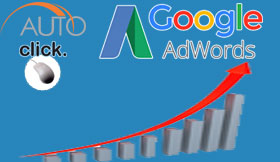
* Unhealthy competition: they are even willing to do many things to destroy competition, like using automated tools to click on competitors’ search ads to make their prices higher. They do those things but sometimes do not think of the consequences happening to the whole market and the opposite effect on themselves. High ads price also come partly from behaviors like these.
Real estate is a long-term industry
But many real estate floors are thinking short-term. Usually, the process of selling real estate has three stages:

Source: conversion.vn
Pre-project: including the preparation of resources, filtering the potential customers from previous projects, figuring out customer needs.
Implementing the project: sales tools need to be built, potential customers need to be found then be consulted about the product and customer information is collected.
After the project: keeping an eye on customer care, keeping in contact with customers, managing and arranging information collected from the project, collecting more information
But now most companies focus only on the stage of implementing and selling the sales project and skip the initial stage of preparation and after-sales phase. Most of the investors and trading floors are still not well managed by their clients for each project. The list of real customers is held by the business staff themselves and at some point if they leave the company, the list is also lost. The company allocates business teams the cost of running ads and finding customers, but until the end, the company does not effectively manage the customer list.
To deal with this issue is not a story of one or two days, but should be the change from the management level above about the need to build a system that can help to manage and follow clients and interact with them on each stage of the buying journey.
And actually because there is no system for managing clients, real estate companies can not do after-sales customer care, and therefore they are not able to implement the pre-sales stage. And the lack of pre-sales preparation will have a direct impact on the sales process of the project.
So what can you do?
If annyone can run an ad on their own, what could you do as a real estate salesman to be competitive with other salespeople? This is a question that hopefully after reading this article, will be able to be answered for you. The answer lies in four elements:
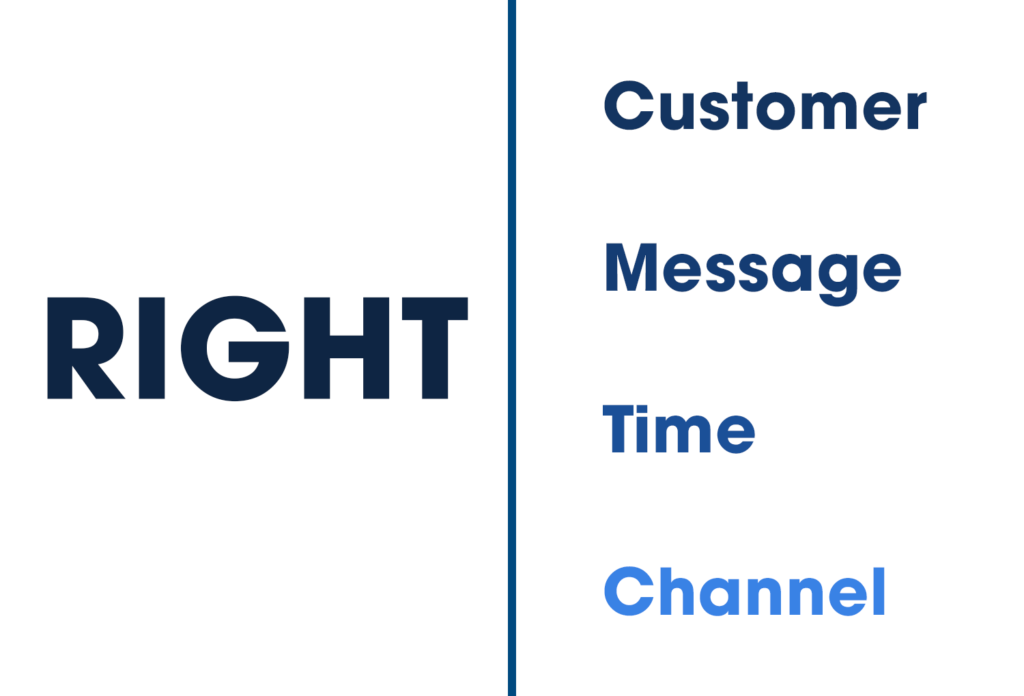
The right customers
The first important factor is to choose the right customers to reach. And to do this you need to understand the concept of the sales funnel:
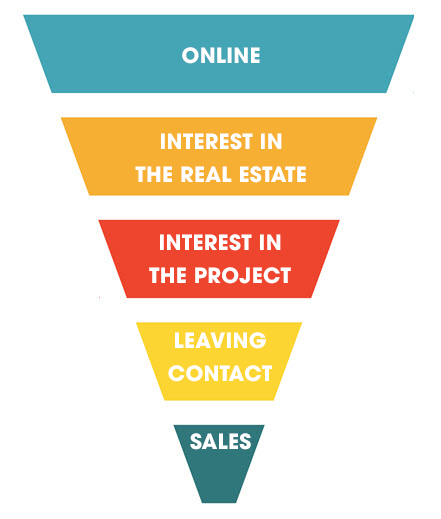
Source: conversion.vn
In my own opinion you can split the sales funnel into the following steps:
– Regular, unspecified online customers: they can be reached via regular ad channels such as news pages, GDN display ads, adnetworks, Facebook, Zalo, etc.
– Customers interested in real estate or a little deeper in just a specific project: you can use channels such as Google, Facebook, news sites such as MuaBanNhaDat.vn, Coc Coc or retargeting.
– Customers who have left contact information on landing page, through call, by filling a lead form or via chat.
– Customers who are being consulted to buy by the sales staff.
There are two things you need to understand: At which steps are you taking to attract customers, by what channels and how can you get more customer data?
To answer the first question, you need to understand that each ad channel has a different targeting capability:
Understanding how each channel is capable of targeting who based on what criteria will help you realize how you should use them to reach the most relevant prospects.
So how can you increase the amount of customer data and using that to sell more? There are 2 ways:
Expanding the sales funnel by increasing the cost of advertising and enlarging the funnel’s input, thereby increasing the sales volume at the bottom of the funnel.

Source: conversion.vn
Pros:
– Quickly increasing the amount of customer information
– Reaching new customers
Cons:
– Cost rising highly
– Increasing quantity means decreasing quality and efficiency (read more).
Optimizing the sales funnel by increasing the conversion rate of each step in the funnel and thereby increasing the sales volume at the bottom of the funnel.

Source: conversion.vn
Pros:
– No additional cost
– Improving long term performance (read more about ad optimization).
Cons:
– Not creating new customers
– Optimization will take time to see the result
Of course, each has its advantages and disadvantages, but what most real estate companies is doing is the first and being less interested in the second one as mentioned above). The most effective way of course is to both expand the sales funnel and optimize to gain maximize efficiency of the spent cost.

The right message
Next we move to the message factor. To be able to convey the right message to our customers, we need to understand who our target customer is. How to build your target audience potrait? Here are some things you can do:
Based on the project information:
– Project location: is it located in the existing residential area or is that a future story?
– Project selling price: Is this project a low, medium or premiere level one?
– Financial policy: how the project supports lending, which banks available for lending
– Added-value convenience: Does the project have a swimming pool, park, supermarket, kindergarten, etc.?
– Project progress: when will this project be completed? In 6 months, 1 year, 2 years?
– Competitive projects: Are there any similar projects nearby?
– How many customer group can this project be sold to? Will they buy a house to live or buy to invest?

Source: gettyimage
Based on customer behavior
– Demographic portraits: How old are the buyers? Male or female?
– Online and offline behavior: Are they active on social networks? What do they do in real life (gym, shopping, driving) and are their everyday activities reflected on social networks? (check-in, joining groups, sharing interests)
– Needs and wants: What do they want when buying this project?
– The problem they are facing in their daily lives: Does the project help them solve the problem?
– The factors affecting their purchasing decision: location, cost, completion time, etc.
– What do they worry, hinder and make them decide not to buy?
Ask the 5W1H questions
This is a classic but always effective method, ask 5W1H questions and answer them yourself.

Source: wikipedia
WHAT – What do they want to buy?
WHERE – Where do they want to buy?
WHEN – When do they want to buy?
WHO – who wants to buy?
WHY – Why do they want to buy?
HOW – How are they going to buy?
Observing and asking your customers: observe the customers and their behavior, and do not be afraid to ask the customers who you are consulting to understand what they want and need.
Using online tools
Here are some tools you can use to learn about customer needs:
Google keyword planner: to see what keywords your customers is searching for for. Link.
Google suggest: to see words that Google automatically suggests each time you enter a keyword in the search box. Keywordtool.io và Ubersuggest.io are two good tools to support this.
Google Analytics: to be provided demographic information, interacts with content, where they come from, and more, based on site visits. Link.
The right time and the right channel
To understand when and where a channel should be used to reach customers, you need to understand where your customers are at which stage of the sales and, on that note, to know which channels can be selected to interact.

Source: conversion.vn
Awareness: This is the stage where customers start to know about the project through channels such as TVC, PR articles in newspapers, WOM (word of mouth), SMS and promotional emails.
Consideration: Customers already know about the project and are considering whether to buy or not. At this point, the best channels to influence their buying decisions may be Facebook ads, search ads, retargeting.
Purchasing: This is the time when they decide to buy the project. Channels that have the potential to impact the customer’s decision include sales staff, PR articles, project websites, and bank information.
Usage: After the project purchase is completed, this is the time when they have the project experience and its service. They can comment on their quality of service on the fanpage of the project, or by joining groups, communities (Facebook messenger, Zalo) or even on their own social networking profile.
Recommendation: If they are satisfied with the quality of the project, they can introduce the project to their friends and acquaintances through WOM, email, social. In addition, if the investor or trader can create good promotions, this can help make this introduction more effective.
You can read more about the channels available in digital marketing here.
You can even do better
Above are some ways you can identify your customers, send them the right message, at the right time and with the right channels. However, you can do better with the following ways:
1. Determining the status of customers
Draw a matrix based on two factors: NEEDS and BEHAVIORS of the client. Each element is divided into 4 levels.

Depending on the level of demand and behavior, we can divide our customers into 4 rather separate groups and through which we can transfer these customers to an appropriate department:
The sales department will handle the customers whose needs and behavior are clear as they are the kind who is ready to buy your project or use the service.
The telesales / customer care department will target customers who demonstrate one or more of these factors but still have insufficient information to effectively be consulted and sold. The mission of this department is to gather enough information before moving on to the sales department.
Marketing will continue to advertise and send different messages to customers who have no information or clear needs to be able to collect more information from them before they can move on. customer care or business department.
2. Developing tables to track KPIs
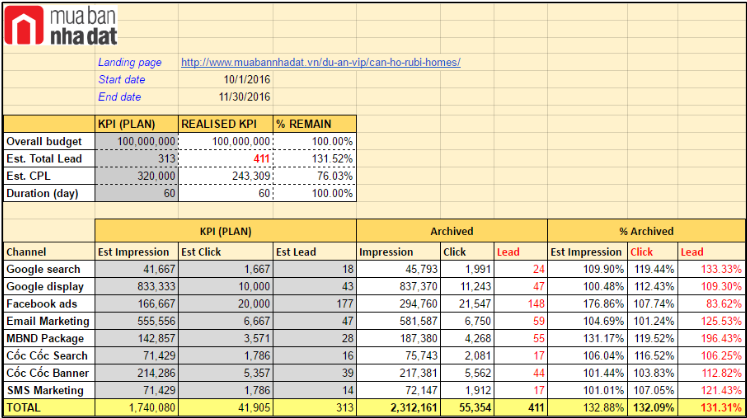
Souce: muabannhadat
Create spreadsheets, excel spreadsheets, or Google Sheets to track the cost of advertising, the cost per customer data, or the conversion rate from customer data to customer consultation or project purchase. You should also create a habit of reviewing data at certain hours of the day, for example, every morning at 9:30 am and at 4:30 pm in the afternoon.
3. Tracking and optimizing ads

Source: muabannhadat
If you are a running ad on your own, this is un deniable and necessary. Digital advertising must be monitored and continually optimized to be effective. You can not just setup the ad and then let it run itself and think that it will bring you customers. Without the regular tracking and optimization in advertising, the efficiency will gradually decrease over time.
If you hire an external service to run ads, you’ll still need to track performance by asking them to report the full metrics so you can measure performance.
4. Being flexible to create competitive advantages
I would like to a picture of a pretty girl to represent the project you want to sell. As I will show you two cases that should and should not be done. The first case is what I see most of the parties are still doing.

Source: muabannhadat
Customers click on the banner and visit the landing page. After landing on the landing page, they exit and then see the retargeting ads pursuing them in other channels. The problem here is that the banner ads that follow are still the banner they clicked on initially and even though they clicked again, they returned to the landing page they had seen before. Obviously banner ads do not change will reduce the CTR, resulting in higher cost per click advertising. Then bringing them back to the site with the same content as before they left was a waste of work. So what should be better?

From the beginning, banner ads should also be diversified. Then when the user landing page then the banner retargeting chasing must also diversify and change so that users are not boring. In addition, the destination of retargeting should not be the landing page they visited before, which could be a PR article, a listing, or a video to provide new content to the user and increase conversion ability.
Throughout all of the above, I have shown you how to target customers, build leads, select channels to deliver your message, choose the right time and share the ways you can do better. Thus I hope to answer the initial question “If anyone can run an ad by themselves, what can you as a real estate salesman do to compete with the other sales staff?” . You can also refer to another Pham Phuoc Nguyen’s article on this subject.
And as I said, this article is set in the realm of real estate, but there are a lot of things that are applicable and useful to many different industries. Hope it will help you to improve the effectiveness of your digital advertising campaigns as well as to reach customers more effectively and properly.



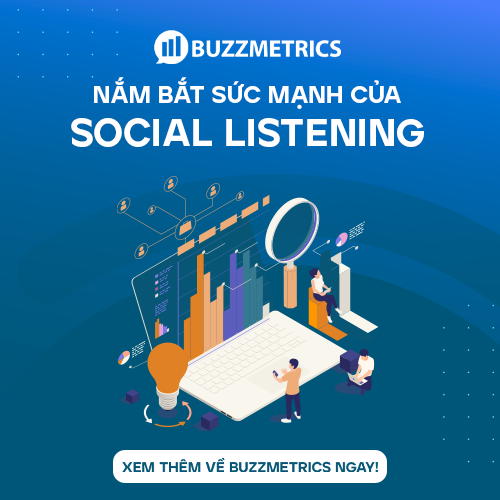
 Vietnamese
Vietnamese English
English